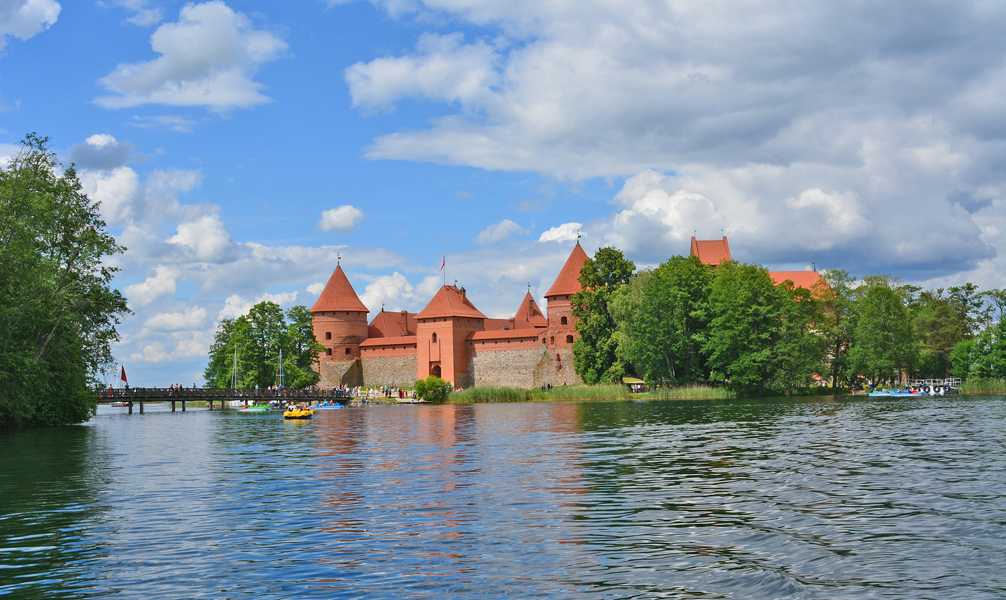Trakai Island Castle is an island castle located in Trakai, Lithuania on an island in Lake Galve. The construction of the stone castle was begun in the 14th century by Kestutis, and around 1409 major works were completed by his son Vytautas the Great, who died in this castle in 1430. Trakai was one of the main centers of the Grand Duchy of Lithuania and the castle held great strategic importance. Construction : First phase : Trakai Island Castle was built in several phases. During the first phase, in the second half of the 14th century, the castle was constructed on the largest of three lake islands by the order of Grand Duke Kestutis. The construction of Trakai Island Castle was related to the expansion and strengthening of the Trakai Peninsula Castle. Kestutis moved his main residence and his treasury to the Island Castle.
The castle suffered major devastation during an attack by the Teutonic Knights in 1377. After the assassination of Kestutis, a power struggle between Jogaila and Vytautas the Great for the title of Grand Duke of Lithuania began. The castle was besieged by both sides. Soon after the reconciliation between Jogaila and Vytautas, the second phase of construction started and continued until 1409. This phase is regarded as the major development in the history of the castle. Apparently, during the truce with the Teutonic Order, the construction works were supervised by the Order’s stonemason Radike, four years before the Battle of Grunwald.
Second phase : During the second phase, two wings were added, and on the southern side a 6-storey (35-metre or 115-foot high) donjon was built. The donjon had movable gates which separated the palace from the forecastle. The donjon was used for several functions; besides serving as another defensive structure, it had a chapel and living quarters. It was linked to the multi-storey Ducal Palace, which had an inner yard. The inner yard had wooden galleries, which ran around the inner wall; these galleries were used to access various support facilities without going inside the palace itself.
The entire southern wing of the southern palace was used for the Ducal Hall. This hall was around 10 by 21 metres (33 ft 69 ft) in size, and only the Upper Palace in the Vilnius Castle Complex could surpass its proportions. The Ducal Hall has preserved some of its original alabar. The principal construction material was so-called red Gothic bricks. Stone blocks were used only in the foundations and the upper parts of buildings, towers and walls. The castle was decorated in a variety of ways, including glazed roof tiling, burned bricks, and stained glass windows. Its overall style after the second construction phase could be described as Gothic with some Romanesque features.
Third phase : The expansion of the forecastle in the early 15th century marked the third phase of Trakai’s development. The walls of the forecastle were strengthened to a thickness of 2.5 metres and raised with additional firing galleries. Three major defensive towers were constructed on the corners. The southwestern tower was also used as a prison. The top story of the towers was designed for soldiers and housed a large number of cannons. A main gatehouse was also constructed which, along with the Ducal Palace donjon, had movable gates. The gatehouse was reinforced with additional sections for firing galleries. Near the inner walls several buildings were constructed, including stables, kitchens, and other support structures. When the castle was undergoing this expansion in the 15th century, the water level of Lake Galve was several metres higher than it is today. The castle builders took advantage of this by separating the Ducal Palace and the forecastle with a moat, just wide enough for small boats to sail through. They were connected by gates that could be raised in case of an enemy attack.
Reconstruction : During the 19th century, castle reconstruction plans were prepared. Its original frescos were preserved and copied by Wincenty Smokowski. The Imperial Archaeological Commission initiated the documentation of the remaining castle in 1888. In 1905, the Imperial Russian authorities decided to partially restore the castle ruins. During World War I, Germans brought in their specialists, who made several attempts to restore the castle. Between 1935 and 1941, parts of the Ducal Palace walls were strengthened, and the southeastern forecastle tower was rebuilt, including sections of its walls. Lithuanian and Polish preservationists worked on the project, but the work stopped when the war gained in intensity. After World War II, a major reconstruction project was begun in 1946; active work started in 1951-1952. The major portion of the reconstruction was finished in 1961. The castle was reconstructed in a 15th-century style.
Trakai Island Castle Museum Ticket rates : For adults 7,00 Eur / For students and senior sitizens 3,50 Eur // Medininkai Castle : For adults 4,00 Eur / For schoolchildren, students and senior sitizens 2,00 Eur Opening Hours : Trakai Island Castle Museum (Karaimų Str. 43 C, Trakai) March, April, October Tuesday – Sunday 10:00 am – 6:00 pm / May -September Monday – Sunday 10:00 am – 7:00 pm / November -February Tuesday – Sunday 9:00 am – 5:00 pm
Trakai Island Castle Museum , Kestučio Str. 4, LT-21104, Trakai

